Wall Street rebounds in volatile trade after steep drops

US stocks rebounded in volatile midday trading on Tuesday, following the biggest one-day declines for the S&P 500 and the Dow in more than six years. Stocks swung up and down after indexes started the session 2 percent lower, underscoring a return of volatility to a market that until recently had been known for the absence of such major shifts.
The sharp declines in recent days marked a pullback long-awaited by investors after the market minted record high after record high in a relatively calm ascent.
“The choppiness this morning is trying to figure out where we should be,” Willie Delwiche, investment strategist at Robert W. Baird in Milwaukee, said. “Some of what we saw yesterday suggests we are near at least a short-term low. Then the question is what the rallies look like after that.”
The Dow Jones Industrial Average rose 247.76 points, or 1.02 percent, to 24,593.51, the S&P 500 gained 18.35 points, or 0.69 percent, to 2,667.29 and the Nasdaq Composite added 70.80 points, or 1.02 percent, to 7,038.33.
U.S. Securities and Exchange Commission Chairman Jay Clayton said he “can’t really say” what caused the dramatic drop in stock prices during recent trading sessions, but that all signs indicate financial markets are functioning normally.
U.S. Treasury Secretary Steven Mnuchin said that recent volatility was not enough to rock market fundamentals.
The market’s pullback comes amid concerns about rising bond yields and higher inflation. These were reinforced by Friday’s January U.S. jobs report that prompted worries the Federal Reserve will raise rates at a faster pace than expected this year.
The question now for investors, who have ridden a nearly nine-year bull run, is whether this is the long-awaited pullback that paves the way for stocks to again keep rising after finding some value, or the start of a decline that leads to a bear market.
Bulls argue that strong U.S. corporate earnings, including a boost from the Trump administration’s tax cuts, will ultimately support market valuations. Bears, including short sellers that bet on the market decline, say that the market is over-stretched in the context of rising bond yields as central banks withdraw their easy money policies of recent years.
“You had people positioned for an environment of lots of central bank easing, low inflation and interest rates and importantly low volatility,” said Brent Schutte, chief investment strategist at Northwestern Mutual Wealth Management Co.
“Now they are having to shift to an environment that looks like you’ll have less central bank easing, rising inflation, rising interest rates and rising volatility.”